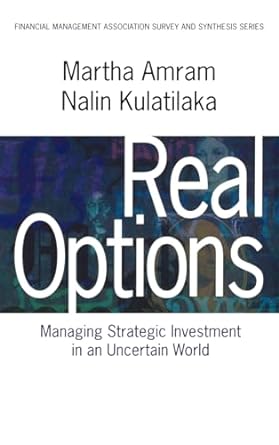Real Options
Managing Strategic Investment in an Uncertain World, By Martha Amram, Nalin Kulatilaka
Summary

| Content | 6/10 |
| Readability | 5/10 |
| Presentation | 7/10 |
| Ideas | 4/10 |
| Value for money | 6/10 |
| Did it do what it said on the box? | 5/10 |
How do the rankings work?
The Review
A rather disappointing book for the general reader
I was rather disappointed by this book.
I was hoping for something which could help explain to business managers why processes such as IT delivery are uncertain, and the value of delivering flexible solutions. The initial part of the book makes a lot of strong qualitative statements of exactly the right sort:
- There is great value in breaking up large projects in uncertain markets
- Options (flexibility) create value out of uncertain events.
- Exit options which allow you to step away from a planned path, even if relatively expensive, may have significant value.
- An option such as an exit option, can make an investment viable when it would fail a traditional NPV test.
- Small speculative investments can enable larger investments to benefit from learning and to be much more accurately targeted.
- It may create greater value to start many projects and abandon more, rather than aiming to abandon a minimum number.
Unfortunately the remainder of the book then supports these statements only for a very limited set of circumstances. The Real Options approach only seems to work if the option can be translated into (or at least mapped onto) a tradeable financial security. There’s no real attempt to provide tools to evaluate internal uncertainty, such as the delivery uncertainty common in IT projects, or the value of flexibility except where it maps to significant investment decisions.
The book does do a good job of explaining that real world situations are non-linear, with value which changes as a result of natural volatility, over time, and as a result of one or more decisions. Traditional NPV-based approaches greatly undervalue flexibility, insurance, learning and platform investments, and can’t really deal with this non-linear aspect. Simply increasing the investment discount rate, which is the usual way of dealing with such problems, doesn’t bring the correct focus onto uncertainty and total risk.
However, the mathematical basis for Real Option valuation is not well explained, and I found the processes difficult to follow. I suspect that the authors implicitly assumed a certain familiarity with economic and financial market techniques and terminology, which limits the value of this book to those seeking, as I was, to apply the techniques to other fields. It also left me puzzled as to why simpler approaches, such as Decision Tree techniques, can’t be used instead.
Surprisingly for a relatively short book the text is very repetitive, and too often turns into a blatant advert for the Real Options approach compared with others, rather than making the case on its own merits.
Hindsight is a great thing, but it is unfortunate that this book praises Enron as an example of success through options manipulation, where we now know this was largely a "long company" scam. Some of the other examples, quoted at the height of the Internet boom, have also not stood the test of time. However, these should not be seen as invalidating the approach, merely as evidence of how uncertain things may really be.
This book provides some good ideas, and if your focus is major business-critical financial transactions it may be very useful. But I’m still looking for a good book on how to generically value flexibility.
Buy It From Amazon
Amazon.co.uk  |  | Amazon.com
|

 Thoughts on the World (Main Feed)
Thoughts on the World (Main Feed) Main feed (direct XML)
Main feed (direct XML)